
Important Warehouse Automation Statistics
Important Warehouse Automation Statistics You Can’t Ignore
Get the latest insight on how you can make your operations run more smoothly through these important warehouse automation statistics
Warehousing is not an easy task. There are countless steps that are part of the warehousing process and completing all of them efficiently can take a lot of effort. If you have a warehouse for your business, it is common that you face a considerable amount of challenges as you try to streamline all your operations and make sure everything is running smoothly.
In today’s day and age, businesses have realized the importance of warehouse automation and how it can help their day-to-day processes. Warehouse automation has grown considerably over the past few years, and it continues to expand more. Businesses now realize how warehouse automation can help them handle all of their operations more efficiently.
If you want to make sure your warehousing is top-notch and you don’t face any trouble with your order fulfillment due to disruptions in your warehousing operations, integrating warehouse automation into your processes can be beneficial for your company.
Before we get into the importance of warehouse automation and the current state of the global warehouse automation market, it is important for you to understand what warehouse automation really is. Let’s take a look at warehouse automation and the different types being used in warehouses currently.
What Is Warehouse Automation?
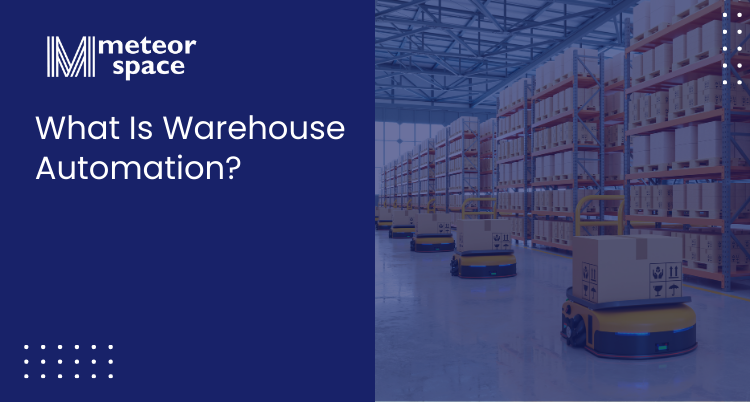
Warehouse automation is when warehouses use the help of different technologies to make sure they can move inventory to, from, and within the warehouse with as little human assistance as possible. When warehouses automate their operations, they take away the need to manually track and record every step in the process. The use of automation tools enables warehouses to cut down on labor, expenses, time, and other resources that can be used for other purposes.
With the help of warehouse automation, many companies have streamlined their operations and made everything more efficient. Automation enables warehouses to avoid performing repetitive tasks manually. For example, picking items from shelves for every order manually can be slow and prone to human error. Using robotics and modular shelving systems allows this process to be automated and efficient, making sure every item picked is accurate.
Using RFID and barcoding to scan, record, and track inventory is another example of automating inventory operations inside the warehouse. It enables companies to improve the accuracy and speed of their processes, and takes away the need to have a large team of workers to help with every process.
When it comes to warehouse automation, there are different categories in which smart technologies and robotics can be used to automate various warehouse operations. The main categories for warehouse automation include:
- Basic warehouse automation
- Warehouse system automation
- Mechanized warehouse automation
- Advanced warehouse automation
Knowing what warehouse automation is can be essential for every business that needs to make sure their warehouse operations are running without any disruptions. In today’s day and age, the importance of warehouse automation is not something that can be overlooked, especially if you want to make sure your business is a success and your order fulfillment is efficient and accurate.
We have compiled a list of statistics that show how important warehouse automation is. These interesting warehouse automation statistics make it clear that warehouse automation has become more common for businesses, and people are willing to incorporate the various smart technologies in their daily operations.
Let’s take a closer look at these warehouse automation statistics!
Latest General Warehouse Automation Statistics
Currently, more than 80% of warehouses lack any form of automation, whereas in contrast, only 5% of warehouses have utilized sophisticated automation technology and solutions over the last decade (businesswire, 2021)
Warehouse automation is a trend that has started to catch on recently. There are still more than 80% of warehouses globally that do not use any type of automation for their operations. In the last one decade, only 5% of warehouses have started using sophisticated automation technology for their warehousing needs. This shows that this sector has just begun growing and expanding, and more warehouses are slowly understanding the importance of automation.
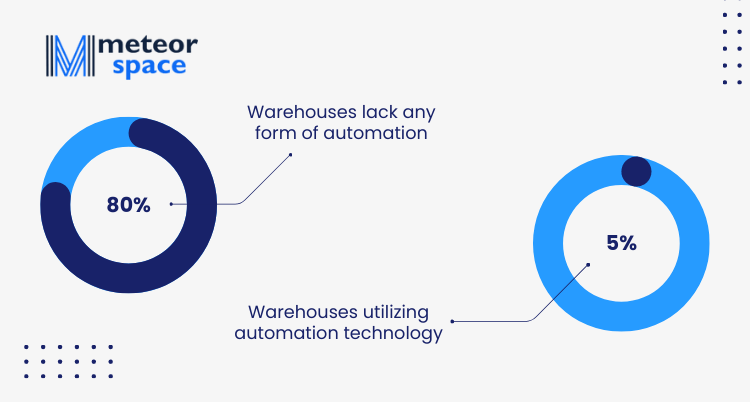
According to estimates, 42% of warehouses and distribution facilities planned to invest in technology and automation in 2018 (amygb, 2022)
Back in 2018, a large number of warehouses (almost 42%) were planning on investing in warehouse automation technology. This is a great statistic that shows how more warehouses are open to accepting the need for automation in recent times, understanding that automation and technology can help them make their operations even more efficient.
According to the data from Peerless Research Group’s (PRG) 2018 annual survey, 40% of respondents planned to invest in conveyors and sortation equipment, 25% in robotics, and 14% in AGVs, and an additional 49% planned to invest in software that runs the equipment such as WES, WMS, or WCS (amygb, 2022)
Warehouses all over the world understand that using different technologies that help them automate some of their operations is beneficial for their business. Back in 2018, a survey showed that 40% of all respondents were planning to invest in various automation technologies, such as sortation equipment, conveyors, robotics, AGVs, and more. 49% of warehouses also planned on investing in some sort of software that can help them manage and control their equipment.
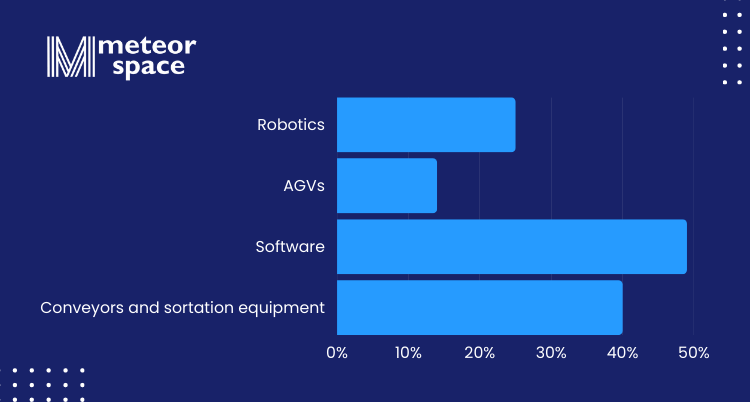
By 2023, warehouse automation technologies such as robotics, logistics, etc. are expected to exceed $22.4 billion globally (amygb, 2022)
The warehouse automation technologies like robotics, logistics, and more, are becoming more common for warehouses everywhere. The market for these technologies has slowly started growing, with the value expected to cross 22 billion USD globally in the year 2023.
In the years to come, warehouse and operations managers anticipate increased spending on material handling equipment and automation, as there was a 52% expectation of greater investment, while 43% anticipated the same expenditures each year (logisticsmgmt, 2021)
According to a survey conducted, more than 50% of warehouse operations managers anticipated an increase in the amount spent on automation equipment and a larger investment on this front. This warehouse automation statistic goes to show how warehouses are now coming to terms with how important automation is for their operations. There is no doubt that automating processes helps with the efficiency and accuracy of the operations, which is why it has become a significant part of every warehouse. With the help of automation, warehouses can make sure all the orders can be fulfilled in the best way possible, which is huge for every business. Achieving accurate and fast order fulfillment can help with retaining customers, building your brand image, creating an excellent shopping experience, and so much more.
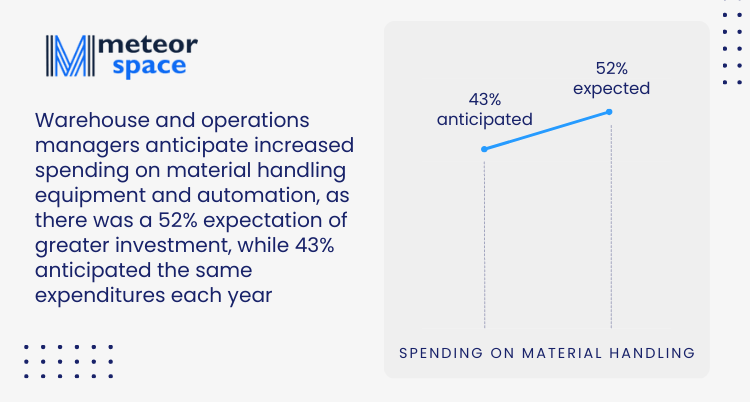
On average, warehouses or distribution centers plan to invest $350,000 in automation, and investments of all sizes can affect this average (logisticsmgmt, 2021)
The average amount warehouses invest in automation is around 350,000 USD. This average amount is also affected by investments of all sizes that warehouses make. As we can see from this statistic, warehouses are investing a lot in automation of their operations, showing us how important warehouse automation has become over the years.
The warehouse automation industry is predicted to increase by more than 38% by 2021 (businesswire, 2021)
Over the years, the warehouse automation industry has grown significantly. As time passes, more warehouses realize how important automation is and how it helps make all their processes more efficient. According to research, the warehouse automation sector grew by 38% in just one year.
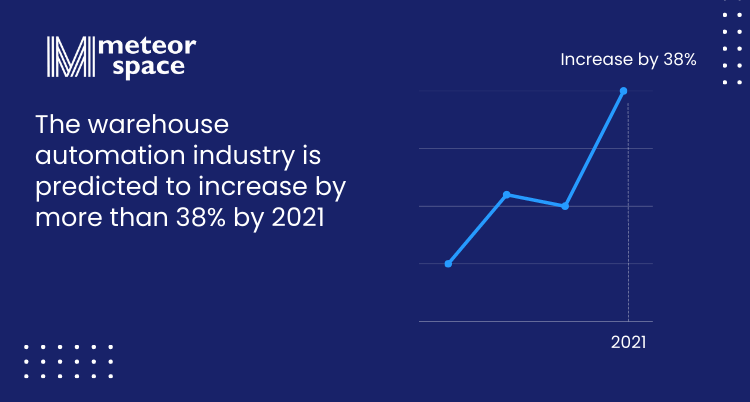
The warehouse automation industry was valued at $15 billion in 2019, representing a 10.9 percent increase over the previous year (businesswire, 2021)
Back in 2019, the warehouse automation industry had a value of around 15 billion USD. This number was a 10.9% increase from the previous year. The warehouse automation industry has grown steadily over the last few years as more warehouses and distribution centers realize that automation is key for their success and they need it to make sure they can keep human errors at a minimum. The global warehouse automation market is expected to drop by 6% by 2020, however, growth of over 38.4 percent is expected this year (2022) to reach $19.5 billion
Although there was a decrease in the warehouse automation market value in 2020, it has not dropped ever since. In 2022, the warehouse automation industry was valued at 19.5 billion USD, which is an increase of over 38% compared to previous years. This is another statistic that shows how warehouse automation is becoming more common with each passing year.
According to predictions, the global warehouse automation market will expand 1.5x in the mid-term (by 2025) and will surpass $37.6 billion by 2030 (businesswire, 2022)
Industry experts have predicted that the global warehouse automation market will be growing significantly over the next few years. The industry is all set to cross the 37 billion USD benchmark by 2030, showing us how rapidly this sector is growing and how the market value is increasing with each passing year.
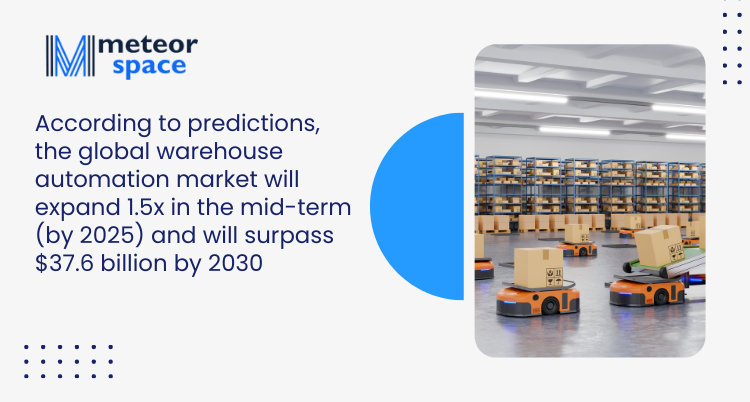
Between 2021 and 2030, the predicted compound annual growth rate for the warehouse automation industry is expected to be about 10% (businesswire, 2022)
According to industry predictions, the warehouse automation market will have a compound annual growth rate of around 10% till 2030, as the industry shows signs of steady growth in the coming years. With warehouses all over the world having more access to technology, automation is going to become more common with each passing year.
It is predicted that at least 620,000 shipments of various warehouse automation technologies will be made worldwide by the end of 2022, and in comparison, approximately 40,000 units were shipped in 2017 (omdia, 2022)
Warehouse automation can help warehouses become more efficient and reduce the risk of errors. This is especially beneficial during order fulfillment, making sure all orders are shipped out fast and are accurate. Warehouse automation has become more common now because warehouses realize how it can help them enhance their performance on a daily basis. Warehouses, distribution facilities, and order fulfillment activities employ 53.7% more people than they did just five years ago when the sector employed an estimated 915,000 people in 2016, and by April 2022, that figure had risen to little over 1,400,000 (omdia, 2022)
The warehouse industry as a whole is growing with each passing year. As retail businesses are increasing, so is the need for warehouses and distribution facilities. Each year, the warehouse industry becomes bigger with more people employed in this sector than before. As the sector grows, so does the use of warehouse automation technology and tools.
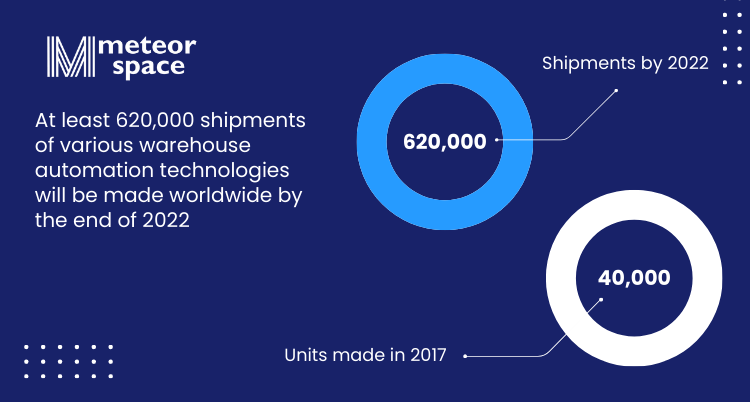
Labor expenditures account for around 65% of most warehouse facility operating budgets, which is a massive sum, far exceeding the price of taxes, utilities, rent (or building maintenance), and distribution combined (conveyco, 2021)
Warehouses need to have an extensive team of skilled workers and the labor expenses can account for almost 65% of all warehouse budgets. This can be a lot and lead to higher running costs for warehouses. Incorporating warehouse automation into the daily operations can help warehouses bring the labor expenses down and save money on that front.
From January 2020 to September 2022, the average hourly wage of all warehouse/logistics employees increased by about 10%, representing some of the highest compensation growth since data collection began (conveyco, 2021)
Over the last couple of years, the average hourly wage of all warehouse employees has increased by almost 10%. This is a huge increase and keeping a large team of workers can be tough and take up most of the warehouse budget. Warehouse automation helps warehouses make sure that they don’t have to rely on workers for even the tiniest tasks and can automate the processes to reduce labor expenses.
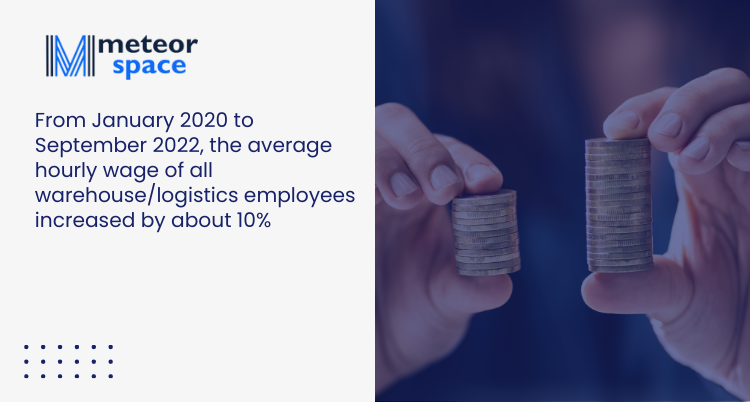
87% of industry decision-makers surveyed are in the process of or planning the expansion of warehouses by 2024 (g2, 2021)
There is a growing need for warehouses as more businesses start every year and are in need for storage space. According to one survey, 87% of decision-makers in the warehouse industry are planning to expand their warehouses in the next two years. As the warehouse industry grows, there is also an increase in the need for warehouse automation.
Use of AGVs (automated guided vehicles) in 2021 held steady from 2020, with 6% currently using and 14% considering/evaluating (g2, 2021)
Automated guided vehicles (AGVs) have become more common in warehouses all around the globe. They have become a huge part of the warehouse automation process. Over the last few years, the use of AGVs has steadily increased and around 14% of warehouses are currently considering using them for their operations.
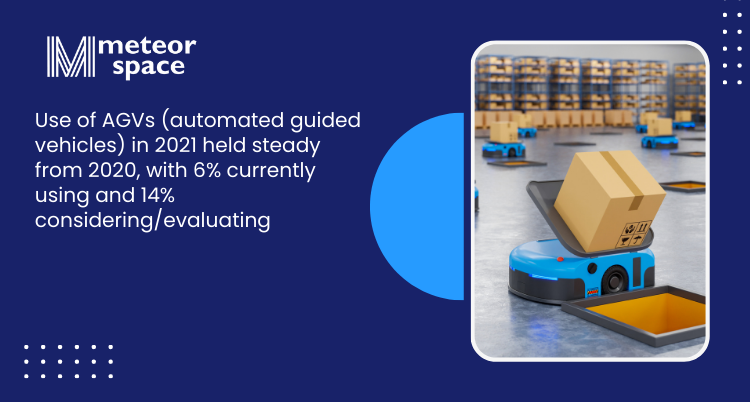
80% of the warehouse activities are outsourced, and 20% remain in-house as your company diversifies geographically (g2, 2021)
A lot of businesses in need of warehousing solutions have decided to outsource their warehouse activities. This also shows how there is a huge need for warehousing services and it is important for warehouses to automate most of their operations if they want to guarantee efficient and accurate services for the businesses that are outsourcing to them.
18,736+ private warehousing establishments are present as of now (g2, 2021)
The need for warehousing and distribution facilities has also given a rise to private warehousing establishments. Currently, there are over 18,736 private warehousing establishments as well. As the number of warehouses increases all over the world, the use of automation technologies and tools is also increasing. The growth of the warehouse automation market continues along with the growth of the warehouse sector.
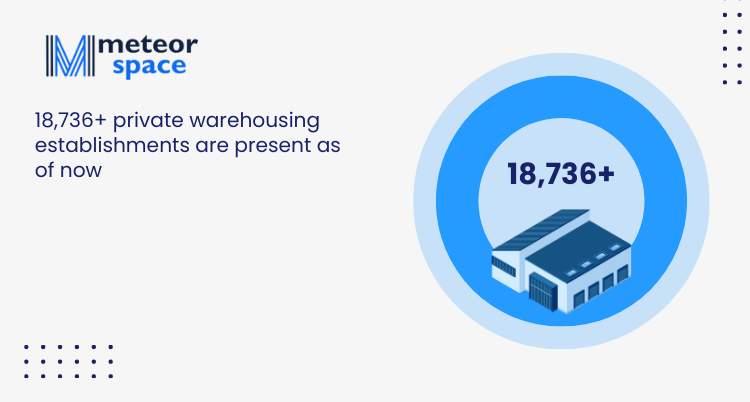
181,370 sq ft is seen as the average size of warehouses, with the trend of larger size warehouses increasing every year (g2, 2021)
The average warehouse size is more than 181,370 square feet. There is a growing trend of having larger warehouses. When the warehouse space is as vast as 180,000 square feet or more, the need for automation also increases. It can be difficult to manage all operations in such a vast space without the help of advanced warehouse automation techniques and tools.
7% sturdy use of Robotics in warehouses for automation systems in 2021 (g2. 2021)
The use of robotics is also on the rise. Robotics can help warehouses carry out operations that they would employ labor for, helping warehouses cut down on labor costs. Robotics also helps warehouses decrease the risk of human errors, which can be crucial for warehouses that carry out order fulfillment for businesses.
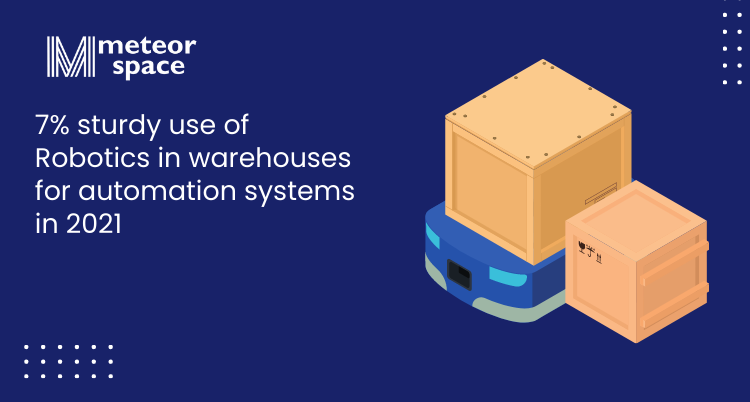
79% of high-performing supply chain companies achieve revenue growth superior to the average within their industries (g2, 2021)
As a supply chain company or warehouse, you need to make sure you can use warehouse automation systems to enhance the performance of your establishment. 79% of high-performing warehouses and supply chain companies achieve higher revenue growth compared to the other average companies in the industry.
Up to 12% of companies aren’t cost-effective when it comes to distribution (g2, 2021)
As a warehouse or distribution center, being cost-effective can help you with your revenue and growth in general. 12% of companies are still not cost-effective when it comes to their distribution, and this can take a toll on their overall revenue as well. Using technology and automation solutions can help companies become more cost-effective and help reduce expenses.
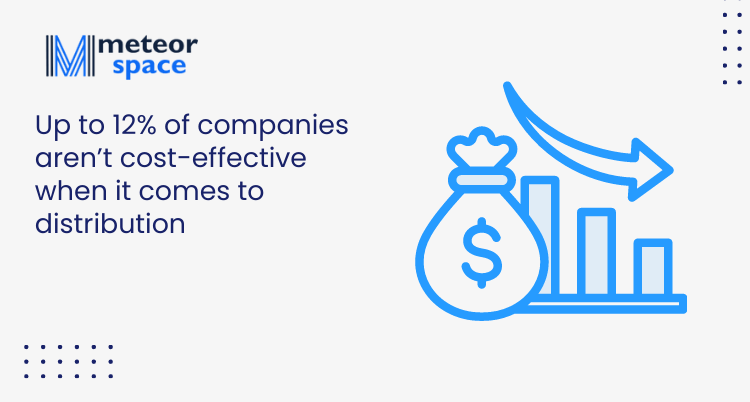
20% of organizations are considering/evaluating robotics for warehouse operations in 2021 (g2, 2021)
In 2021, around 20% of organizations were looking at robotics solutions that would help them automate their warehousing operations. This is a huge percentage and shows us how more warehouses are considering using automation for their day-to-day operations. As more warehouses realize how important warehouse automation can be, there is an increase in the use of technology like robotics.
72% say Warehouse management systems (WMS) is the popular warehouse management software in 2020 (g2, 2021)
Around 72% of respondents in a survey believe that using a warehouse management system to manage their warehouse processes and operations is the best option for them. A warehouse management system (WMS) can help you keep track of all inventory and orders and manage them effectively from one platform. It can be crucial when it comes to order fulfillment and generating accurate inventory forecasts for businesses as well.
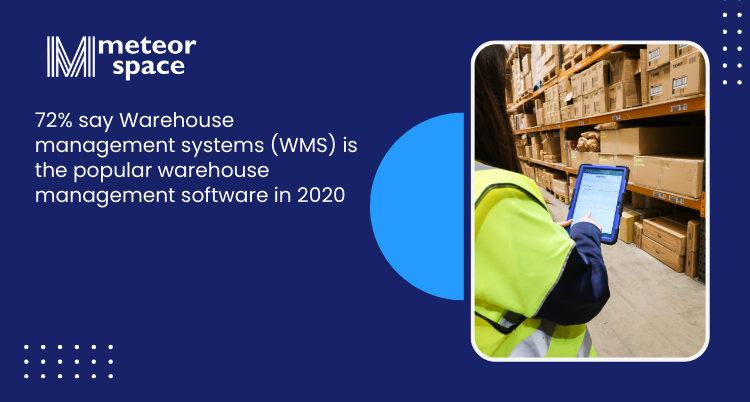
Transportation Management System leads 56% of the warehouse management software usage (g2, 2021)
Managing transport of goods, inventory, orders, etc., is not an easy task and using a transportation management system has become increasingly popular within warehouses. Around 56% of warehouse management software is related to transport management systems, which help warehouses keep track of all the goods that are coming into the warehouse or leaving the warehouse.
Warehouse Automation Adoption Statistics
27% of decision-makers from Manufacturing, Transportation & Logistics, and other departments plan to utilize full automation by 2024
Most of the decision makers in the warehousing industry realize the importance of using automation for their operations. Around 27% of them want to utilize full automation by the year 2024.
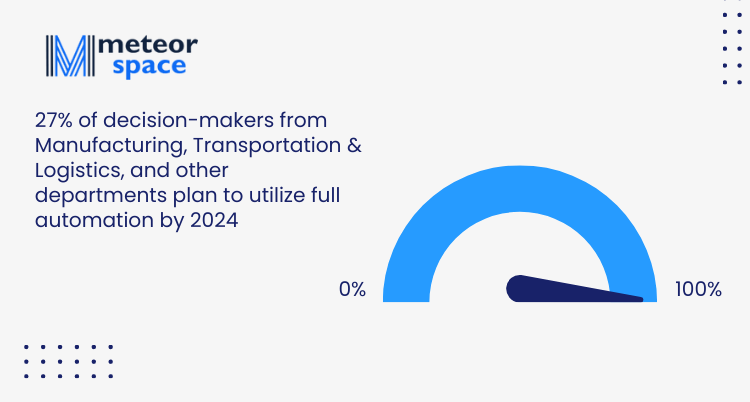
Worldwide shipments of warehousing and logistics robots will multiply over the next five years from 194,000 units in 2018 to 938,000 units annually by 2022
As more warehouses begin adopting automation technologies for their warehouse operations, the number of shipments for warehouse and logistics robots will increase significantly over the years. This increase can also be seen in the last five years.
62% of respondents reported human error from manual process management as the no.1 root cause of inventory fulfillment issues, which can be improved with a sound fleet management system
According to one survey, 62% of warehouses claim that human error from manual process management is the top cause of inventory and order fulfillment problems. The use of warehouse automation systems can help decrease the risk of human error.
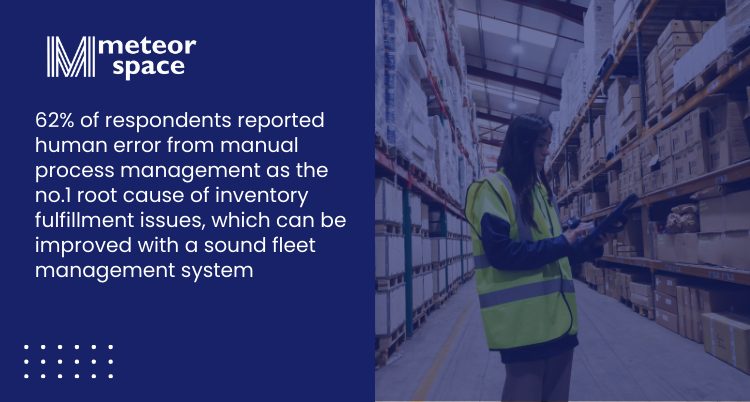
On-time delivery of orders is the solution to 40% of respondents for making happy & lifelong customers, and this can be achieved by implementing automated inventory solutions, automated storage, and retrieval systems, reducing human errors
40% of respondents in a survey believe that delivering orders to their customers on time is the best way to build a happy and loyal customer base. Warehouse automation also helps carry out fast and accurate order fulfillment, making sure customers are always satisfied with their orders.
96% of industry leaders identify innovation as an essential factor to growth (vs. 65 percent of followers)
If you want to become successful and make sure your business is growing steadily, you need to become an innovator. According to 96% of industry leaders, innovation is essential for growth in any sector. 60% of companies expect to invest in conveyor systems and sortation systems over the next three years
In the coming years, the use of warehouse automation technologies is going to become even more common. Around 60% of companies are going to invest in conveyor and sortation systems in the next three years, showing us once again how more warehouses are now realizing the importance of automating their processes in any way they can.

48% of leaders believe in early adopters of disruptive technologies and use 3D-Printing “extensively.”
When it comes to using automation technologies in warehouses, a lot of companies feel uncomfortable with it as they are not familiar with the technology. However, almost 50% of industry leaders believe in adopting disruptive technology early and are using things like 3D printing extensively.
75% of industry leaders believe in the utilization of software for extensive analytics
The utilization of software for in-depth and extensive analytics has become more common, with 75% of industry leaders using software for these purposes. With the help of the right software, you can understand industry trends and how you are performing at different levels.

76% of those surveyed in 2020 expected increased investment in real-time location systems that track inventory and assets throughout the warehouse compared to 2019, when it was 51%
There are different location systems that can be used to track the movement and location of inventory and other goods throughout the warehouse. The investment in these location systems has increased significantly over the years, allowing warehouses to keep better track of all the items moving within the facility.
80% out of 1,400 IT and Operational Decision-Makers agree that over the next five years, new technology is needed to keep up with ecommerce demands
According to 80% of industry experts, the ecommerce demands are growing and there will be a need for new technology to keep up with these demands in the coming years. Warehouses need to be open to adopting new software and technologies in their operations to help them enhance their performance and meet consumer demands.

The food and Beverage industries are having the largest revenue share in the Logistics Automation Market in 2020, making it the largest industry, with 80% of its total investment in equipment and machinery
When it comes to the warehouse automation market, the food and beverage industry has the largest market share. 80% of the total investment made by the food and beverage industry is for equipment and machinery that helps them automate their logistics processes and warehousing.
40% of companies are looking forward to investing in shuttle systems for warehouse processes
Various systems like shuttle systems are becoming more common as warehouses realize how they can enhance their operations and make everything a lot more efficient. Around 40% of companies are looking to make an investment in shuttle systems, and this percentage will only increase in the coming years. Source: (G2, 2021)
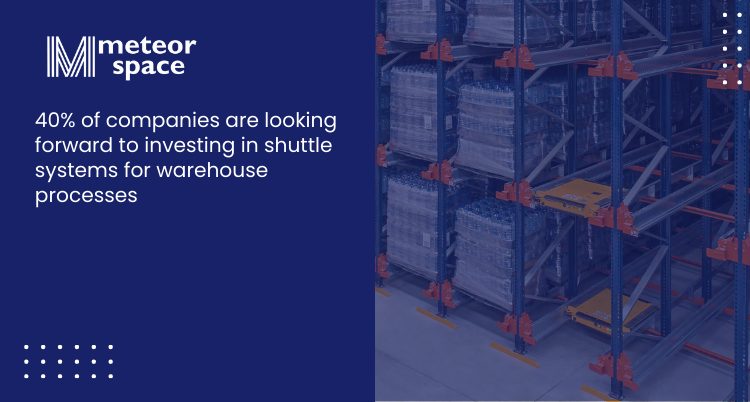
Warehouse Automation Labor Statistics
Amazon Robotics uses 80,000+ autonomous mobile robots to automate the order fulfillment centers
The use of autonomous mobile robots has increased significantly over the years, with Amazon Robots using more than 80,000 AMRs to automate the order fulfillment centers.
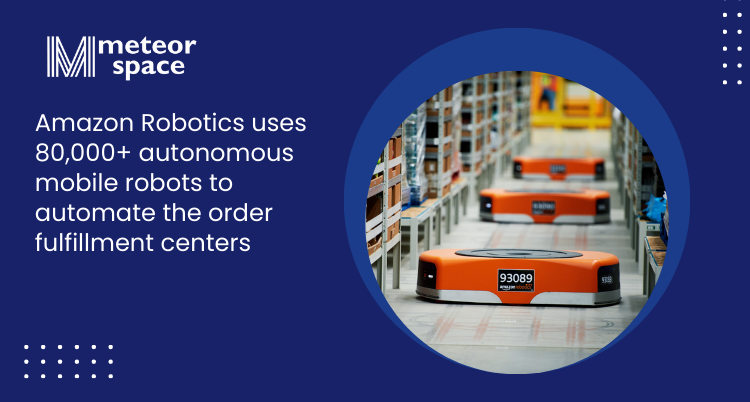
10x growth opportunity is predicted for Autonomous Mobile Robots (AMRs) by 2025
By 2025, the use of autonomous mobile robots will increase even more and the growth opportunity for AMRs is going to be ten times greater than it is right now.
15% to 20% growth in cross-border ecommerce will increase the demand for modern warehouses and automation systems
The growth in cross-border ecommerce is leading to an increase in the demand for modern warehouse automation systems all over the world. As the ecommerce sector grows, so does the warehouse industry and the need for warehouse automation.
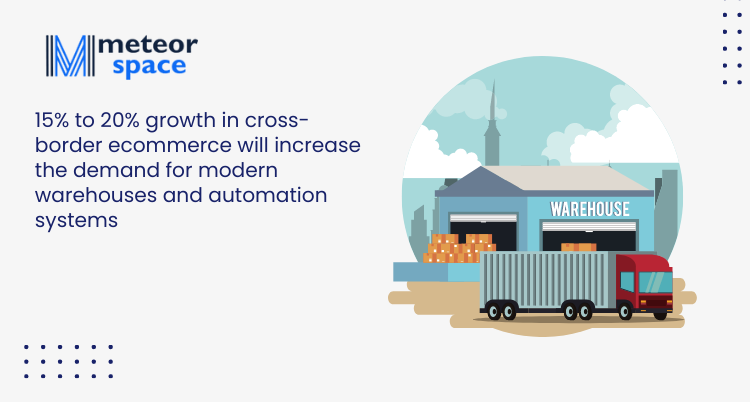
89% of organizations surveyed will be using modernized Warehouse Management Systems functionality for labor planning and management by 2024
According to a survey, by 2024, 89% of organizations will be using advanced and modernized warehouse management systems for labor management and planning purposes.
Increased use of robotics has the potential to drive a 25% to 30% reduction in average manufacturing and labor costs
The use of robotics in the warehousing sector can help warehouses reduce the average labor and manufacturing costs by 25 to 30%.
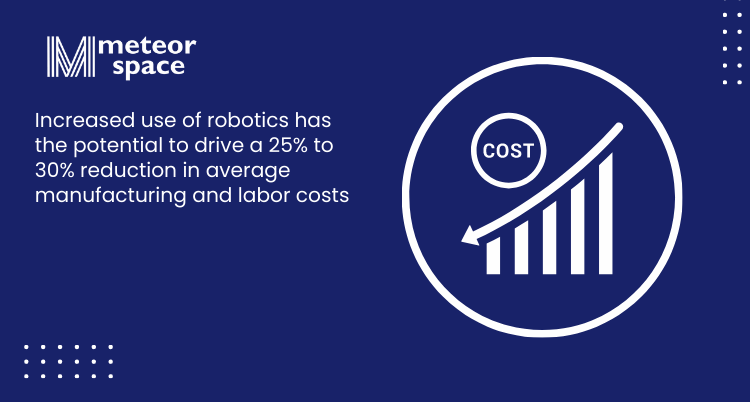
The rate of nonfatal occupational injuries and illnesses among private industry employees was 2.8 cases per 100 full-time equivalent workers in 2019
When there are more workers in a warehouse, there is also an increased risk of non-fatal occupational injuries and illnesses. Through warehouse automation and the use of robotics, this can be decreased.
2.5 percentage points higher unemployment rate can be seen compared to pre-pandemic level
The unemployment rate in the warehousing sector has increased during the pandemic and it is now 2.5% higher than it was pre-pandemic.

54% of organizations are increasing supply chain and technical training to retain laborers and develop a career path for valued employees
There is still a high percentage of organizations that are providing technical training for their workers to help them develop a career path.
From February 2020 to February 2021, the average hourly earnings for production and nonsupervisory employees increased by 3.2 percent
In the past few years, there has been an increase in the average hourly earnings for non-supervisory employees in the warehousing sector as well.
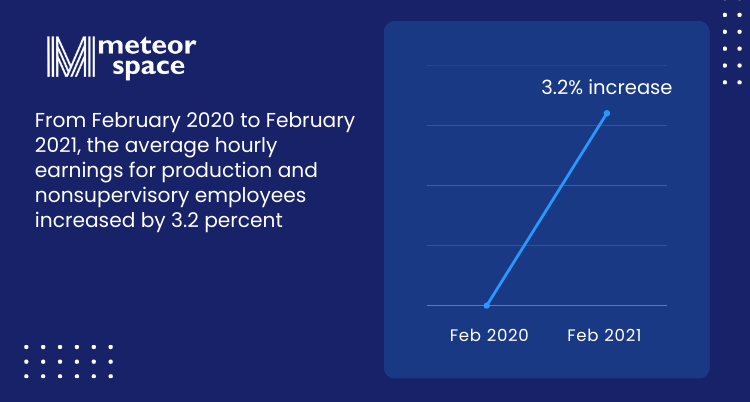
73% believe that the optimum balance in warehousing includes human interaction, with 39% supporting partial automation, and 34% supporting Augmentation (equipping workers with devices)
73% of people in the warehousing sector still believe that to maintain the optimum balance in warehousing, human interaction is still required. Around 39% support partial warehouse automation and 34% believe that workers should be equipped with devices and technology for automation.
Source: (G2, 2022)
Team Up With A Leading Warehouse For All Your Fulfillment Needs
Having a warehouse is crucial if you run a retail business. However, managing your warehouse operations is not an easy task and can take up a lot of time, labor, and effort. Without the right help, your warehouse operations might not be efficient or accurate, which can take a toll on your order fulfillment, ultimately leading to you losing out on sales and customers.
If you want to make sure all your order fulfillment operations, including inventory and order management, run as smoothly as possible, teaming up with a leading warehouse facility can be the best option for you. This is where Meteor Space comes in! Here, we make sure we can provide the best order fulfillment for your business from our state-of-the-art warehousing and fulfillment center.
Meteor Space uses some of the latest technologies, making sure most of our warehouse and fulfillment operations are automated. This helps us reduce the risk of human errors and inaccuracies when it comes to order fulfillment for your business. Here at Meteor Space, we make sure your customers always receive fast and accurate deliveries, helping you increase your sales and build a loyal customer base.
Our warehouse spreads across 200,000 square feet, making sure we always have enough space for all of your inventory. We also provide you with access to an advanced warehouse management system, helping you track all orders and inventory from one dashboard. With our help, you don’t have to worry about getting storage space for your inventory, picking and packing orders, shipping orders, and a lot more.
Meteor Space takes away all your stress, allowing you to cut down on your overhead expenses and focus on creating even better marketing strategies to grow your businesses. When you team up with Meteor Space, you can unlock the full potential of your business and keep your customers happy with their shopping experience.
Sounds like the perfect match for you? Get in touch with us to get started right away!
Get started today